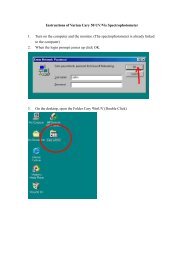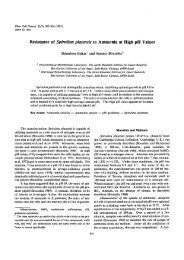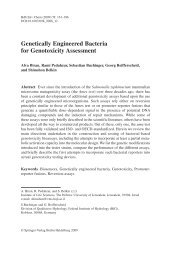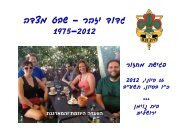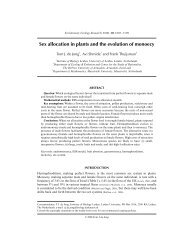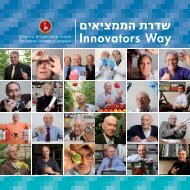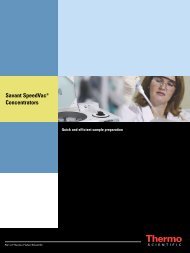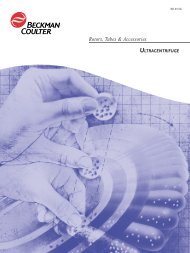LIQUID SCINTILLATION COUNTING
LIQUID SCINTILLATION COUNTING
LIQUID SCINTILLATION COUNTING
You also want an ePaper? Increase the reach of your titles
YUMPU automatically turns print PDFs into web optimized ePapers that Google loves.
C<br />
C<br />
C<br />
C<br />
Place your sample vials with background vial into the LSC tray (or belt) and place into the<br />
LSC.<br />
Set count time, noting that shorter count times give poor counting statistics.<br />
Set your LLD, ULD, and Gain as appropriate and begin your counting.<br />
Unless the counter is programed to calculate dpm you will need to calculate the true<br />
radioactivity of the sample in units of dpm by dividing the sample cpm by the counter<br />
efficiency for that energy of the sample (i.e., dpm = cpm/eff). As previously discussed, the<br />
counter efficiency may be different for different vials depending on the amount of<br />
quenching present.<br />
BECKMAN LSC CONSIDERATIONS<br />
All LSCs operate in the same manner, but different manufacturers may use different terminology<br />
or offer more options than others. Some systems allow the user to select the regions of interest<br />
by selecting a keV range of interest. Others offer several options (channel or keV). Most of the<br />
comments made so far apply to Packard style counting systems, where the user selects the energy<br />
regions. The channels correspond to energy in 0.5 keV increments; that is, the 4000 channels are<br />
each ½keV wide, so the system can detect energies from 1-2000 keV.<br />
If you are using a Beckman counting system, usually the channel option is the default option for<br />
the window setting. Beckman counting systems have 1000 channels and the energy is related to<br />
the equation:<br />
Channel # = 72 + 280 log 10 (E max )<br />
where E max is in keV. Thus the ULD channel settings on a Beckman LSC to detect the maximum<br />
possible beta energy for 3 H, 14 C/ 35 S and 32 P would be approximately 400, 670 and 1000<br />
respectively.<br />
CERENKOV <strong>COUNTING</strong><br />
Some beta emitting isotopes can be analyzed on an LSC without using any cocktail. The<br />
liturature of several manufacturer’s discusses counting high energy (E max > 800 keV) beta emitters<br />
without cocktail or with only a little water, using a technique called Cerenkov counting.<br />
When high energy beta particles travel faster than the speed of light relative to the medium they<br />
are traversing (e.g., water, etc.) Cerenkov radiation (i.e., light) is produced. Cerenkov radiation is<br />
the blue light that you see when you look into a reactor pool. Cerenkov radiation allow some<br />
beta emitting radionuclides to be analyzed with a liquid scintillation counter without using any<br />
cocktail. For Cerenkov radiation to be produced, the beta particle must exceed a minimum<br />
threshold energy (E th ) which is calculated by:<br />
E th = 511 n - 511<br />
% n 2 - 1<br />
In this equation, 511 is the rest mass of an electron in keV and n is the refractive index of the<br />
medium (i.e., n glass = 1.5, n water = 1.33). Consider, for example, using water instead of cocktail.<br />
12



